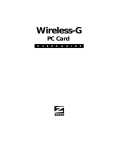Download Zoom 4410B User guide
Transcript
Wireless-G USB Adapter U S E R G U I D E 2 Wireless-G USB Adapter Contents Overview .................................................................. 4 1. Installation Instructions ...................................... 5 Installing and Connecting the Adapter.................... 6 The Adapter LED.................................................... 9 2. Setting Security ................................................. 10 Accessing the Security Screen ............................. 11 WPA2-PSK (Pre-Shared Key) .............................. 14 WPA-PSK (Pre-Shared Key) ................................ 15 WEP (Wired Equivalent Privacy) .......................... 16 WPA2 ................................................................... 18 WPA ..................................................................... 20 Certificate (WPA2 and WPA)................................ 23 WiFi™ Protected Setup (WPS) ............................ 24 Changing your Security Setting ............................ 26 3. Advanced Options............................................. 27 Creating Profiles ................................................... 27 Monitoring Link Status .......................................... 30 Using Site Survey and Rescan ............................. 31 Advanced Configuration ....................................... 33 Appendix A. TCP/IP Settings................................ 34 Appendix B. Troubleshooting .............................. 41 Appendix C. Technical Support ........................... 43 Appendix D. Regulatory Information ................... 47 Contents 3 Overview The chapters in this User Guide describe how to: • Install the Zoom Wireless-G USB adapter on a Windows® PC • Connect to a wireless network • Enable security on the Wireless-G USB adapter • Use the advanced features of the Wireless-G USB configuration software Chapters 1 and 2 cover the basics – what you need to get connected and to enable security. If you are interested in the more advanced features of the Wireless-G USB adapter, please see Chapter 3. This chapter explains how to create profiles so you can switch your connection from one network to another, monitor the strength of your network connection, and scan a list of available networks. 4 Wireless-G USB Adapter 1 Installation Instructions This chapter provides simple instructions for installing the Wireless-G USB adapter on a Windows PC. If you have already installed the adapter on a computer (using the separate Quick Start guide), you can skip this chapter and begin with Chapter 2: Setting Security. What’s in the Package The adapter package includes the following: • Wireless-G USB adapter • USB extension cable • CD containing the Installation Wizard and documentation • Quick Start manual Before You Begin Before you install the Wireless-G USB adapter, check that your computer has the following: • • Available USB port Windows Vista, XP or 2000 Chapter 1: Installation Instructions • • CD drive 6 MB of free hard drive space 5 Installing and Connecting the Adapter Important! Install the software BEFORE you plug the WirelessG USB adapter into your computer. 1 Insert the Wireless-G USB CD into the CD or DVD drive. The CD should start automatically. Windows Vista: If the AutoPlay dialog box appears, click Run Setup.exe. If a message appears saying An unidentified program wants access to your computer, click Allow. 2 On the Language Selection screen, select your language. 3 On the next screen, select Installation Wizard, and then on the following screen select USB. 4 On the Zoom Wireless-G USB Welcome screen, click Next to install the adapter. A Zoom Wireless-G USB Setup screen is displayed for a few seconds while the installation proceeds. 6 Wireless-G USB Adapter Windows Vista: If a message tells you that Windows can't verify the publisher of the driver software, select Install this driver software anyway. 5 At the prompt, click Finish and remove the CD. If the Zoom installation menu remains on screen, click Exit. 6 Shut down the computer. 7 Plug in the USB Adapter and turn your computer back on. To connect to a network 1 Double-click the Zoom Wireless-G USB icon on your desktop to open the Zoom Wireless-G Configuration window. Note that you also have a Zoom Wireless-G USB icon in your Windows taskbar: The color of this icon indicates the status of your network connection: Blue indicates an excellent or good link. Yellow indicates a usable but weak link. Red indicates no link or a very poor link. Chapter 1: Installation Instructions 7 2 In the Zoom Wireless-G USB window, click the Site Survey tab to see a list of available wireless networks. 3 Highlight the network you want and click Join. If the network you select has security configured, you must enable and configure security on your computer before you can connect. See Chapter 2, Setting Security. 4 If you join a wireless network that does not have security, you should now be connected. To check your connection, open your Web browser and go to your favorite site. We highly recommend security. Chapter 2, Setting Security on page 10 has descriptions of the six security options and setup instructions. If you have difficulty accessing the Internet, follow the suggestions in your browser’s “Page cannot be displayed” message. You may need to adjust your LAN settings. As you work online, you can monitor your connection easily using the Link Status icon described in Step 1 above. 8 Wireless-G USB Adapter The Adapter LED The states of the LED on the Wireless-G USB adapter are explained below. LED Status Meaning Flashing The Wireless-G USB adapter is attempting to connect to a wireless network. Steady The Wireless-G USB adapter is connected to a wireless network and is transmitting or receiving data. Chapter 1: Installation Instructions 9 2 Setting Security We strongly recommend security, although you do not need to use it to get your wireless connection working. Important! You must first enable security on the the wireless access point. You then enable security on the adapter using the same configuration that you used for the access point. For example, if the wireless access point is configured for WPA2PSK, you must select WPA2-PSK security in the Wireless-G USB configuration software and enter the same encryption key. Select one of six ways to configure and implement security for your wireless network: • WPA2-PSK (WiFi ® Protected Access 2 Pre-Shared Key) This is the option we recommend, if it is supported by the access point and the devices in your network. WPA2-PSK protects your communications with AES (Advanced Encryption Standard). Some access points permit a “mixed mode” network composed of both WPA and WPA2 wireless clients. WPA2-PSK requires you to enter an encryption key shared by the access point. • WPA PSK (WiFi ® Protected Access Pre-Shared Key) If the devices in your network do not all support WPA2-PSK, select WPA-PSK. WPA-PSK protects your communications with TKIP (Temporal Key Integrity Protocol). 10 Wireless-G USB Adapter This option requires you to enter an encryption key shared by the access point. • WEP (Wired Equivalent Privacy) Both the Open and Shared Authentication modes require WEP security. The most recent assessments of WEP advise choosing Open rather than Shared. If the devices in your network do not support WPA2-PSK or WPA-PSK, select Open with WEP data encryption. This method requires you to enter an encryption key. The keys can be 64, 128 or 256 bits in length. • WPA2 If you are linking to a corporate network that accesses a RADIUS (Remote Authentication Dial-In User Service) authentication server, and if the devices in the network support WPA2, select WPA2. This option provides security with AES (Advanced Encryption Standard). AES has a key size of 128, 192, or 256-bits. In order for eavesdroppers to decipher a message, they would have to try every possible key. • WPA is an option for corporate users who access a RADIUS (Remote Authentication Dial-In User Service) authentication server that does not support WPA2. WPA provides security with TKIP (Temporal Key Integrity Protocol), which dynamically changes keys as the system is used. Accessing the Security Screen 1 On your desktop, double-click the Zoom Wireless-G USB icon: Chapter 2: Setting Security 11 2 3 12 The Zoom Wireless-G USB configuration software opens to display the configuration parameters: Make sure that the desired wireless network is displayed in the Profile and SSID text boxes (the term <Infra> designates an Infrastructure network) and that the Network Type is correct. There are two types of wireless networks: Infrastructure and Ad Hoc. • In an Infrastructure network, wireless devices communicate with each other via a wireless access point, router, or ADSL modem with built-in wireless technology. • In an Ad Hoc network, a group of wireless devices communicate directly with other “client” devices that are using wireless adapters. The network does not include a wireless access point or wireless router. Wireless-G USB Adapter • 4 In the unlikely event that you use an Ad Hoc network, you must set up Static IP addressing. See Appendix A: TCP/IP Settings. Select the Enable Security check box to open the Security Configuration window. For configuration instructions, consult this table: To configure Go to page WPA2-PSK 14 WPA-PSK 15 WEP 15 WPA2 18 WPA 20 Chapter 2: Setting Security 13 WPA2-PSK (Pre-Shared Key) 1 2 3 4 5 6 In the Privacy Configuration window, click the Authentication Mode drop-down arrow and select WPA2PSK. At Encryption Mode, accept the default: AES (Advanced Encryption Standard). In the Pre-shared key [WPA] area, enter the same network key that is used on the wireless access point. We advise you to enter a key with a minimum of 20 random characters. Click OK to save your settings and return to the Configuration tab. On the Configuration tab, click Apply. Click the Close box to exit the configuration software. That’s it! You have configured WPA2-PSK security for your wireless connection, and you’re ready to use the Internet. 14 Wireless-G USB Adapter WPA-PSK (Pre-Shared Key) If all of the wireless devices in your network DO NOT support the recommended WPA2-PSK, select WPA-PSK. 1 2 3 4 5 6 In the Privacy Configuration window, click the Authentication Mode drop-down arrow and select WPAPSK. At Encryption Mode, accept the default: TKIP (Temporal Key Integrity Protocol). In the Pre-shared key [WPA] area, enter the same network key that is used on the wireless access point. We advise a key with a minimum of 20 random characters. Click OK to save your settings and return to the Configuration tab. On the Configuration tab, click Apply. Click the Close box to exit the configuration software. Chapter 2: Setting Security 15 That’s it! You have configured WPA-PSK security for your wireless connection, and you’re ready to use the Internet. WEP (Wired Equivalent Privacy) 1 In the Privacy Configuration window, click the Authentication Mode drop-down arrow and select Open (recommended) or Shared: The USB Adapter automatically selects WEP as the Encryption Mode. 2 In the Preconfigured key [WEP] area, do the following: a In the Format for entering key drop-down list, select • ASCII characters if your network uses all Zoom wireless products 16 Wireless-G USB Adapter • Hexadecimal digits if an access point, router, or some adapters are not Zoom products b In the Key Length drop-down list, select 128 bits, 64 bits, or 256 bits. Note: 128-bit and 256-bit WEP provide more security than 64-bit, but the longer keys could diminish network performance. c In the Key Index drop-down list, if you are using a 64-bit key, select which of four keys – 1, 2, 3, or 4 – will be used to encrypt the data. The key you select must be the same one that is selected on the access point. We recommend that you use Key 1. 128-bit and 256 bit WEP use just a single key. d In the Network Key text box, enter a key using the table below as a guide. The key must be the same for all the devices on your network. 3 4 5 If you selected key type… Enter exactly… Hexadecimal digits – 256 bits 58 Hexadecimal characters A–F, a–f and 0–9. Hexadecimal digits – 128 bits 26 characters A–F, a–f and 0–9. For example, 00112233445566778899AABBCC. Hexadecimal digits – 64 bits 10 characters. The characters can be A-F, a-f, and 0-9. For example, 11AA22BB33. ASCII – 128-bits 13 characters. The characters can be any upper- or lower-case letters and numbers. For example: MyKey12345678. ASCII – 64 bits 5 characters. The characters can be any upper- or lower-case letters and numbers. For example, MyKey. Re-enter the key in the Confirm Network Key text box. Click OK to save your settings and return to the Configuration tab. On the Configuration tab, click Apply. Chapter 2: Setting Security 17 6 Click the Close box to exit the configuration software. That’s it! You have configured WEP security for your wireless connection, and you’re ready to use the Internet. WPA2 Select WPA2 if: • you are linking to a corporate network that uses a RADIUS (Remote Authentication Dial-In User Service) authentication server • all of the devices in the network support WPA2, or your access point offers both WPA2 and WPA. 18 Wireless-G USB Adapter 1 2 3 4 In the Privacy Configuration window, click the Authentication Mode drop-down arrow and select WPA2. At Encryption Mode, accept the default AES (Advanced Encryption Standard) In the IEEE 802.1X Authentication area, note that the check box marked Enable IEEE 802.1X authentication for this network is selected. With IEEE 802.1X authentication, each wireless device (client) sends a signal to the wireless access point, which in turn sends the signal to the RADIUS server. The server determines whether or not the client is allowed to join the network. Click the EAP (Extensible Authentication Protocol) Type drop-down list and select an authentication protocol: • PEAP (Protected Extensible Authentication Protocol). This is the default. With PEAP, you can select from two authentication extensions: MS-CHAPV2. Microsoft’s version of CHAP (Challenge-Handshake Authentication Protocol (default) GTC • TLS (Transport Layer Security). There are no authentication extension options with TLS. Chapter 2: Setting Security 19 • TTLS (Tunneled Transport Layer Security). With TTLS, you can select from four authentication extensions: PAP (Password Authentication Protocol) CHAP (Challenge Handshake Authentication Protocol) MS-CHAP (Microsoft’s version of CHAP). MS-CHAPV2 (the default). • 5 6 7 8 SIM (Subscriber Identity Module). A SIM card stores the key used to identify a subscriber to a wireless service. Click the Certification tab and enter the required information (see page 23). Click OK to save your settings and return to the Configuration tab. On the Configuration tab, click Apply. Click the Close box to exit the configuration software. That’s it! You have configured WPA2 security for your wireless connection, and you’re ready to use the Internet. WPA Select WPA if you are linking to a corporate network that uses a RADIUS (Remote Authentication Dial-In User Service) server that does not support WPA2. 1 20 In the Privacy Configuration window, click the Authentication Mode drop-down arrow and select WPA. Wireless-G USB Adapter 2 3 4 Accept the default Authentication Mode: TKIP (Temporal Key Integrity Protocol). In the IEEE 802.1X Authentication area, note that the check box marked Enable IEEE 802.1X authentication for this network is selected. With IEEE 802.1X authentication, each wireless device (client) sends a signal to the wireless access point, which in turn sends the signal to the RADIUS server. The server determines whether or not the client is allowed to join the network. Click the EAP (Extensible Authentication Protocol) Type drop-down list and select an authentication protocol: Chapter 2: Setting Security 21 • PEAP (Protected Extensible Authentication Protocol – the default). With PEAP, you can select from three authentication extensions: MS-CHAPV2 (the default). This is Microsoft’s version of CHAP (Challenge-Handshake Authentication Protocol. GTC • TLS (Transport Layer Security). There are no authentication extension options with TLS. • TTLS (Tunneled Transport Layer Security). With TTLS, you can select from four authentication extensions: PAP (Password Authentication Protocol), the most basic form of authentication. CHAP (Challenge Handshake Authentication Protocol) MS-CHAP (Microsoft’s version of CHAP). MS-CHAPV2 • 5 6 7 8 SIM (Subscriber Identity Module). A SIM card stores the key used to identify a subscriber to a wireless service. Click the Certification tab and enter the required information (see page 23). Click OK to save your settings and return to the Configuration tab. On the Configuration tab, click Apply. Click the Close box to exit the configuration software. That’s it! You have configured WPA security for your wireless connection, and you’re ready to use the Internet. 22 Wireless-G USB Adapter Certificate (WPA2 and WPA) A certificate is issued to a wireless network user by a Certificate Authority – often the corporate network administrator – to confirm the user’s identity and thereby maintain the security of the network. If you are linking to a corporate network that uses an authentication server and you have configured WPA2 or WPA security, your MIS staff will assist you in completing the Certification information. Chapter 2: Setting Security 23 WiFi™ Protected Setup (WPS) If your access point supports WiFi Protected Setup (WPS), this protocol can greatly simplify the process of configuring WPA2PSK or WPA-PSK security. To access WPS, on the Configuration tab, click the WPS button to open the WPS Config screen: 1 2 24 If you are like most users, you will want to join a wireless network (WLAN), so select Join a WLAN (Enrollee) and click Next. On the next screen, select either Push Button configuration or PIN configuration: Wireless-G USB Adapter a You can select the Push Button option if your access point has a hardware Secure Setup or similarly named button, or a virtual pushbutton on a software display. Before you initiate WPS by clicking Next, go to the access point and activate its pushbutton. The access point will begin accepting WPS connections. Now, on the Adapter WPS Config screen, click Next to have the Adapter automatically configured with the security that is set up on the access point. (If security has not been set on the access point, a random SSID and WPA key will be used.) b You can select PIN configuration if the access point does not have a hard or soft security pushbutton. In the text box, the Adapter's randomly generated PIN number will be displayed. Before you click Next, go to the access point, enter the Adapter's PIN number in the appropriate place on the access point's configuration interface, and click a button -- called Start PIN or something similar -- to activate a search for the Adapter. When the access point identifies the Adapter, it will automatically configure security. Now click Next to complete WPS. Chapter 2: Setting Security 25 Changing your Security Setting If the type of security on your wireless network changes, you need to modify your security settings. On the Configuration tab, click the Configure Security button to select a different security option and enter the required information. 26 Wireless-G USB Adapter 3 Advanced Options The Zoom Wireless-G USB utility provides options so you can create profiles, monitor the signal strength of your network connection, scan available networks, and specify advanced settings. This chapter tells you when and how to use each of these options. Creating Profiles A profile is a collection of settings needed for a particular wireless connection. If you plan to use more than one network, you can create a profile for each one and then switch to its profile when you want to connect to that particular network. For example, you may want to set up profiles for a work network and a home network, each of which has different configuration settings. By creating two profiles, you can store the settings for each network and then switch quickly and easily from one network to the other by selecting the appropriate profile. 1 2 On your desktop, double-click the Zoom Wireless-G USB icon. On the Configuration tab, in the Profile text box, enter a name for the profile you want to create. For example, let’s say you have a small home network to which you want to be able to switch quickly when you arrive home. Give the profile the name “Home”: Appendix A: TCP/IP Settings 27 3 In the Configuration area, enter the following settings: • SSID – Enter the network name. In the example above, the SSID is Home. • Network Type – From the drop-down list, select Ad Hoc. • Ad Hoc channel – From the drop-down list, select the channel used by the other device(s) in the network. If you are setting up the first computer in the network, select a channel. Also, to avoid interference, it is desirable to have a 5channel difference between your channel and the channel being used by another network within range. Click Site Survey, then Rescan to check the channel settings of other networks within range. If you are unsure of which channel to use, select Channel 6. 28 Transmit Rate – Select Auto to allow your device to adjust automatically in the case of interference or a weak connection. If you want to specify a fixed speed, choose one from the drop-down list. Most people should select Auto. Wireless-G USB Adapter • Enable Security – Select this check box to open the Security Configuration window. Note: If you are setting up an ad hoc network, as in this example, only WEP security is available to you. After you enter your security settings, click OK to return to the Configuration tab. 4 5 In the Configuration area, click the Apply button to save the settings. Click the Save button to save the Profile. Appendix A: TCP/IP Settings 29 Monitoring Link Status The Status area on the Configuration tab displays information about your wireless connection: • State: In an Infrastructure • Link Quality (Infrastructure network, the name and the MAC address of the wireless access point to which your computer is connected. In an ad hoc network, the virtual MAC address used by computers in the network. • Current Channel: The Wi-Fi frequency channel. • Current Tx (Transmission) Rate: Highest transmission speed in Megabytes per second of the last received packet. • Throughput (Packets/sec): TX = number of packets transmitted per second without errors. RX = number of packets received per second without errors. only): The transmission quality of the last received packet. 80 – 100% = Excellent 60 – 80% = Good 40 – 60% = Fair Under 40% = Poor or no connection • Signal Strength (Infrastructure only): The transmission signal strength of the last received packet, expressed as a percent of maximum allowable power. Note: you may be able to improve the signal strength by using the supplied extension cable to place the adapter in a more favorable location. 80 – 100% = Excellent 60 – 80% = Good 40 – 60% = Fair Under 40% = Poor or no signal strength 30 Wireless-G USB Adapter Using Site Survey and Rescan Use the Site Survey window and the Rescan button when you need to do any of the following: • Find a list of network names (ESSIDs) so you can connect to a network • Identify the MAC address (BSSID) of your wireless access point or wireless router • Check the channel difference between your network and other networks within range • Check the network type (infrastructure or ad hoc) of your network • Verify whether security is enabled for your network To use this window, click the Site Survey tab, then click the Rescan button to refresh the list. Appendix A: TCP/IP Settings 31 The information displayed on the Site Survey tab is as follows: • ESSID (Extended Service Set Identifier): An Extended Service Set consists of two or more Basic Service Sets (see below). An ESSID, also known as an SSID or Network Name, is chosen by the person who sets up the network. The ESSID is a code attached to all packets sent over an infrastructure wireless network. The code can contain up to 32 alphanumeric characters. All devices in the network must share the same ESSID. • BSSID (Basic Service Set Identifier): A Basic Service Set consists of a wireless access point connected to wired network and a set of wireless devices. In an infrastructure network, the BSSID is the MAC address of the wireless router or wireless access point. In an ad hoc network, the BSSID is the MAC address of the first computer in the network to be powered up. 32 • Channel: The Wi-Fi frequency channel. • Network Type: Infrastructure or Ad Hoc (see page 12). • Security: The type of security configured for the network. • Signal: The strength and quality of your transmissions. • Supported rates (data transfer speeds): In wireless networks the data rates are typically 11Mb/s or 54Mb/s. The rates depend on signal strength and quality. Wireless-G USB Adapter Advanced Configuration To access this window, click the Advanced button on the Configuration tab. • Wireless Mode: • Power Save Enabled: When you select this option, the Wireless-G USB adapter immediately signals the access point that it is in Power Save mode. The access point buffers all packets until it is polled by the adapter. Note: The access point you use must also support Power Save. Appendix A: TCP/IP Settings • Frag (Data fragmentation) Threshold: If your adapter often transmits large files, you can set a limit on packet size. If the limit is exceeded, the adapter will split the packet. The default is Disabled (2346). • Country Roaming: 33 Appendix A TCP/IP Settings By default, Windows is set for dynamic addressing (DHCP). Generally, this is the correct setting for an Infrastructure network, but needs to be changed if you are using an Ad Hoc network. (Note: Use our instructions as a basic guide. Advanced users will know other ways to set up their networks.) Please go to the section that corresponds to your Windows operating system. Windows Vista 1 Follow these steps to open the TCP/IPv4 or TCP/IPv6 Properties dialog box. a From the desktop, click the Start button, select Control Panel, and then double-click Network and Sharing Center. b In the Network and Sharing Center window, under Tasks, select Manage Network Connections: 34 Wireless-G USB Adapter c In the Network Connections window, double-click the Wireless Network Connection option: d In the Wireless Network Connection Status dialog box, click the Properties button: Appendix A: TCP/IP Settings 35 e In the Wireless Network Connection Properties dialog box, highlight the version of TCP/IP (Transmission Control Protocol/Internet Protocol) that you are using and click the Properties button: f If you have an ad hoc network, continue with Step 2 below. If you have an infrastructure network, continue with Step 3 below. If you're not sure what kind of network you have, refer to page 12. 2 For Ad Hoc Networks: In the TCP/IPv4 or TCP/IPv6 Properties dialog box, on the General tab, complete the following to set static IP addressing: a Ensure that Obtain an IP address automatically is not selected. Then select the buttons labeled: Use the following IP address and Use the following DNS server addresses. b If this is the first computer to be set up in the ad hoc network, enter 10.0.0.5 for an IP address. If you are adding it to an existing ad hoc network, increment the last digit by one, for example, 10.0.0.6, 10.0.0.7 36 Wireless-G USB Adapter c Enter 255.255.255.0 for Subnet mask. The Subnet mask should be the same for each computer in your ad hoc network. d Enter 10.0.0.5 for Default gateway and Preferred DNS server. (This is the IP address of the first computer that was set up in your ad hoc network.) The Default Gateway and Preferred DNS server should be the same for each computer in your ad hoc network. e Click OK twice. That’s it! You have set static IP addressing for a Windows Vista computer in an ad hoc network. 3 For Infrastructure Networks: To verify your DHCP settings, complete the following: a Ensure that Obtain an IP address automatically is selected. b Select either Obtain a DNS server address automatically or Use the following DNS server addresses. All text boxes for static IP addressing should be blank. If you select Use the following DNS server addresses, enter your preferred and alternate server addresses. Appendix A: TCP/IP Settings 37 c Click OK twice to exit. That’s it! You have verified your DHCP settings for a Windows Vista computer in an infrastructure network. Windows XP 1 Follow these steps to open the Internet Protocol (TCP/IP) Properties dialog box. a From the desktop, click the Start button, select Control Panel, and then click Network Connections. b Right-click the Wireless Network Connection icon, and select Properties. c In the Wireless Network Connection Properties dialog box, select Internet Protocol (TCP/IP) from the list, and click the Properties button. d If you have an ad hoc network, continue with step 2a. If you have an infrastructure network, continue with step 3a. If you’re not sure what kind of network you have, refer to page 12. 2 For Ad Hoc Networks: Complete the following to set static IP addressing: a Ensure that Obtain an IP address automatically is not selected. Then select the buttons labeled: Use the following IP address and Use the following DNS server addresses. b If this is the first computer to be set up in the ad hoc network, enter 10.0.0.5 for an IP address. If you are adding it to an existing ad hoc network, increment the last digit by one, for example, 10.0.0.6, 10.0.0.7 c Enter 255.255.255.0 for Subnet mask. The Subnet mask should be the same for each computer in your ad hoc network. d Enter 10.0.0.5 for Default gateway and Preferred DNS server. (This is the IP address of the first computer that was set up in your ad hoc network.) The Default 38 Wireless-G USB Adapter Gateway and Preferred DNS server should be the same for each computer in your ad hoc network. e Click OK twice. That’s it! You have set static IP addressing for a Windows XP computer in an ad hoc network. 3 For Infrastructure Networks: To verify your DHCP settings, complete the following: a Ensure that Obtain an IP address automatically is selected. b Ensure that either Obtain a DNS server address automatically or Enable DNS is selected. All text boxes for static IP addressing should be blank. c Click OK twice to exit. That’s it! You have verified your DHCP settings for a Windows XP computer in an infrastructure network. Windows 2000 1 Follow these steps to open the Internet Protocol (TCP/IP) Properties dialog box. a From the desktop, click the Start button, point to Settings, then click Network and Dial-up Connections. b Right-click the Local Area Connection icon, and select Properties. c In the Properties dialog box, in the Connect Using box, make sure the Zoom Wireless-G USB adapter is displayed. From the Components list, select Internet Protocol (TCP/IP) and click the Properties button. d If you have an ad hoc network, continue with step 2. If you have an infrastructure network, continue with step 3. Appendix A: TCP/IP Settings 39 2 Complete the following steps to set static IP addressing: a In the Internet Protocol (TCP/IP) Properties dialog box, ensure that Obtain an IP address automatically is not selected. Then make sure the buttons labeled Use the following IP address and Use the following DNS server addresses are selected. b If this is the first computer to be set up in the ad hoc network, enter 10.0.0.5 for IP address. If you are adding it to an existing ad hoc network, increment the last digit by one, for example, 10.0.0.6, 10.0.0.7 c Enter 255.255.255.0 for Subnet mask. The Subnet mask remains the same for each computer in your ad hoc network. d Enter 10.0.0.5 for Default gateway and Preferred DNS server. (This is the IP address of the first computer that was set up in your ad hoc network.) The Default Gateway and Preferred DNS server should be the same for each computer in your ad hoc network. e Click OK twice. That’s it! You have set static IP addressing for a Windows 2000 computer in an ad hoc network. 3 For Infrastructure Networks: To verify your DHCP settings, complete the following: a Ensure that Obtain an IP address automatically is selected. b Ensure that either Obtain a DNS server address automatically or Enable DNS is selected. All text boxes for static IP addressing should be blank. c Click OK twice to exit. That’s it! You have verified the DHCP settings for your Windows 40 Wireless-G USB Adapter Appendix B Troubleshooting ¾ If your Zoom Wireless-G USB adapter is not working properly, try these suggestions. • Make sure the adapter is securely connected to the computer, either directly or through its USB extender cable. • Perform a power cycle – take the following steps in the order given: 1. Turn off the computer. 2. Turn off your wireless router, gateway or access point and wait a few seconds. 3. Turn the router, gateway or access point back on. 4. Turn on the computer. 5. Try again to connect your wireless adapter to a network. ¾ • If you are using the short USB cable, try changing the orientation of the USB adapter. • Turn the computer off, then on, and then check to see if the adapter is working. • Make sure that the adapter is not physically damaged. • Try the adapter in another USB port. • Unplug other USB devices from your computer one at a time and see if that causes the adapter to work. • If possible, try installing the adapter on another computer. If the problem does not seem to be hardware-related, click the Zoom icon on your desktop to run the Wireless-G USB software. 1 Check the Configuration tab to make sure that the SSID and Network Type settings for the adapter are the same Appendix B: Troubleshooting 41 as these settings for the other devices in your wireless network. 2 Then click the Security tab and check the settings to make sure that the adapter is configured for the same security system as the other devices in your wireless network. Make sure that your security key is the same – remember that the keys are case-sensitive. 3 Check your TCP/IP settings as discussed in Appendix A of the User Guide. 4 If the adapter still does not work, uninstall the software and then re-install it. Unplug the adapter from the USB port, then select Start, All Programs, Zoom Wireless-G USB, Uninstall Zoom Wireless-G USB. Then re-install the Wireless-G USB software. If the above solutions do not work, consult Technical Support. Please see Appendix C: Zoom Technical Support Services on page 43. 42 Wireless-G USB Adapter Appendix C Zoom Technical Support Services Zoom has a variety of technical support services available to our customers. We strive to provide convenient, professional support responsive to our customers’ needs and capabilities. If you find yourself unable to get your Zoom product to operate, and you have thoroughly reviewed your owner’s manual and all relevant documentation, please feel free to contact us for help. For your records, and to facilitate Technical Support from either your equipment supplier or Zoom, please record the following information when you receive your Zoom product. Product Information Product Name __________________________________ Product Model Number __________________________________ Product Serial Number __________________________________ Date Installed _______________________ The serial number (S/N) is located on the adapter next to the S/N barcode. Please be sure to write the number down. This will greatly speed up your service and insure that the service representative is addressing the proper Zoom product. Calls to Zoom’s voice technical support staff are the most time consuming, and at times you may find it difficult to get through. We do not want you left on hold for long periods of time, so we limit the queue length. We recommend that you take the time to familiarize yourself with the other services described in this section before calling. Many questions can be answered more quickly using e-mail or our World Wide Web Home page. Appendix C: Zoom Technical Support Services 43 World Wide Web Zoom’s Web page lets you send email for assistance, register on-line, access product reviews and descriptions, and do a whole lot more. Visit the Zoom Technical Support area for the latest Flash Files and Drivers for your Zoom Product. To access Zoom’s Web page, please log onto your local Internet Service Provider, then go to the Web browser and select: www.zoom.com From Zoom’s home page you can easily go to Technical Support or many other useful areas. Smart Facts™ Q&A Search Engine (English Only) Smart Facts™ is an automated intelligent database of Frequently Asked Questions (FAQ’s) about Zoom products. It allows you to search for solutions to your Technical Support questions, by product or via a powerful Keyword Search Engine. If you still cannot find a solution to your question, SmartFacts lets you access our Technicians via email for a personalized response. SmartFacts provides you with a way to track the history of your problem and to add or change the description without having to enter any information that was previously sent. SmartFacts can even contact you automatically if there is an update to your hardware or software that helps to address the question you had. You can access SmartFacts from www.zoom.com/techsupport 44 Wireless-G USB Adapter Contact Zoom by Email You can email Zoom with any tech support questions you might have and one of our Technical Support Engineers will respond by email within 2 business days. You may request personal assistance via email at www.zoom.com/techmail. When emailing Zoom, be sure to include the following: • Serial number of your adapter • Your full name and address • A detailed description of your problem Contact Zoom by Phone You can reach Technical Support by calling these numbers: In the United States, call (617) 753-0961. In the UK, call 0870 720 0090. Certain other countries can dial an in-country number to reach Zoom Technical Support: Portugal: +35 1221451012 Spain: +34 911516304 Switzerland: +41 435000369 Appendix C: Zoom Technical Support Services 45 Return of Defective Units Please contact your local distributor or reseller for Factory Authorized Repair or Replacement of your In-Warranty Defective Product. If you are unable to reach your distributor, you can contact the Zoom Factory Customer Service by calling: US: (617) 753-0023 UK: 0870 720 0090 Please note that the customer is responsible for any charges (including brokerage or customs and duties) associated with shipping the defective unit to Zoom for repair. During the first year Zoom will pay return shipping to the customer by common carrier. After the first year the customer may be required to pay a shipping and handling fee. Any applicable customs, duties and brokerage charges to import the product are the responsibility of the customer. Zoom encourages all customers to return defective units to their respective reseller whenever possible. 46 Wireless-G USB Adapter Appendix D Regulatory Information U.S. FCC Part 15 Emissions Statement This equipment has been tested and found to comply with the limits for a Class B digital device, pursuant to part 15 of the FCC Rules. These limits are designed to provide reasonable protection against harmful interference in a residential installation. This equipment generates, uses and can radiate radio frequency and, if not installed and used in accordance with the instructions, may cause harmful interference to radio communications. However, there is no guarantee that interference will not occur in a particular installation. If this equipment does cause harmful interference to radio or television reception, which can be determined by turning the equipment off and on, the user is encouraged to try to correct the interference by one or more of the following measures: • Reorient or relocate the receiving antenna. • Increase the separation between the equipment and receiver. • Connect the equipment into an outlet on a circuit different from that to which the receiver is connected. • Consult the dealer or an experienced radio/TV technician for help. This device complies with Part 15 of the FCC Rules. Operation is subject to the following two conditions: (1) This device may not cause harmful interference, and (2) this device must accept any interference received, including interference that may cause undesired operation. FCC Caution: Any changes or modifications not expressly approved by the party responsible for compliance could void the user's authority to operate this equipment. IMPORTANT NOTE: IEEE 802.11b or 802.11g operation of this product in the U.S.A. is firmwarelimited to channels 1 through 11. Industry Canada Emissions Statement This Class B digital apparatus meets all requirements of the Canadian Interference-Causing Equipment Regulations. Cet appareil numérique de la classe B respecte toutes les exigences du Règlement sur le matériel brouilleur du Canada. Operation is subject to the following two conditions: 1) this device may not cause interference and 2) this device must accept any interference, including interference that may cause undesired operation of the device. Appendix D: Regulatory Information 47 Countries of Operation & Conditions of Use in the European Community This device is intended to be operated in all countries of the European Community. Requirements for indoor vs. outdoor operation, license requirements and allowed channels of operation apply in some countries as described below: Note: The user must ensure that the channels of operation are in conformance with the spectrum usage rules for European Community countries as described below. • This device will automatically limit the allowable channels, as determined by the setup program during installation, by examining the operating system's current country of operation. If the country of operation is not determined, the device will default to US settings. Use of the incorrect country of operation may result in operation not in accordance with local regulations, and may cause harmful interference to other systems. The user is obligated to ensure that the device is operating according to the channel limitations, indoor/outdoor restrictions and license requirements for each European Community country as described in this document. If configured incorrectly, you can contact technical support for instructions on changing the device's spectrum usage. • This device may be operated indoors or outdoors in all countries of the European Community using the 2.4 GHz band: Channels 1 - 13, except where noted below. ¾ In Italy the end-user must apply for a license from the national spectrum authority to operate this device outdoors. ¾ In Belgium outdoor operation is only permitted using the 2.46 - 2.4835 GHz band: Channel 13. ¾ In France outdoor operation is only permitted using the 2.4 - 2.454 GHz band: Channels 1 - 7. Electrostatic Discharge Statement The unit may require resetting after a severe electrostatic discharge event. 48 Wireless-G USB Adapter Declaration of Conformity Declaration of Conformity Déclaration de conformité Konformitätserklärung Dichiarazione di conformità Declaração de Conformidade Konformitetsdeklaration Overensstemmelseserklæring Conformiteitsverklaring van de EU Δήλωση Συμμόρφωσης Deklaracja zgodności Declaración de conformidad Cam kết về sự tuân thủ ở Châu Âu Manufacturer/Producent/Fabrikant/ Constructeur/Hersteller/Κατασκευαστής/ Fabbricante/ Fabricante/Tillverkare/ Nhà sản xuất Zoom Technologies, Inc. 207 South Street Boston, MA 02111 USA / 617-423-1072 www.zoom.com Brand/Varemærke/Merk/Marque/Marke/ Μάρκα/Marchio/Marka/Marca/Thương hiệu Zoom Wireless-G USB Adapter Type/Typ/Μάρκα/Tipo/Kiểu mẫu Model 4410B The manufacturer declares under sole responsibility that this equipment is compliant to Directive 1999/5/EC via the following. This product is CE marked. Producenten erklærer under eneansvar, at dette udstyr er i overensstemmelse med direktivet 1999/5/EC via følgende. Dette produkt er CE-mærket. De fabrikant verklaart geheel onder eigen verantwoordelijkheid dat deze apparatuur voldoet aan Richtlijn 1999/5/ EC op grond van het onderstaande. Dit product is voorzien van de CEmarkering. Le constructeur déclare sous son entière responsabilité que ce matériel est conforme à la Directive 1999/5/EC via les documents ci-dessous. Ce produit a reçu le marquage CE. Hiermit erklärt Zoom die Übereinstimmung des Gerätes modem mit den grundlegenden Anforderungen und den anderen relevanten Festlegungen der Richtlinie 1999/5/EC. Dieses Produkt ist das gekennzeichnete CE. Ο κατασκευαστής δηλώνει με αποκλειστική του ευθύνη ότι αυτό το προϊόν συμμορφώνεται με την Οδηγία 1999/5/ΕC μέσω των παρακάτω. Αυτό το προϊόν φέρει τη Σήμανση CE. Il fornitore dichiara sotto la sola responsabilità che questa apparecchiatura è compliant a 1999/5/EC direttivo via quanto segue. Questo prodotto è CE contrassegnato. Producent stwierdza że to urządzenie zostało wyprodukowane zgodnie z Dyrektywą 1999/5/EC. Jest to potwierdzone poprzez umieszczenie znaku CE na urządzeniu. O fabricante declara sob sua exclusiva responsabilidade que este equipamento está em conformidade com a Directiva 1999/5/EC através do seguinte. Este produto possui Marcação CE. El fabricante declara bajo su exclusiva responsabilidad que este equipo satisface la Directiva 1999/5/EC por medio de lo siguiente. Este producto tiene marca CE. Nhà sản xuất cam kết với trách nhiệm của mình là thiết bị này tuân theo Hướng dẫn 1999/5/EC thông qua các mục sau. Sản phẩm này được đánh dấu là CE. 73/23/EEC – LVD 89/336/EEC – EMC 1999/5/EC EN 60950-1:2001 EN 301 489-1, v1.4.1: 2002-08 EN 301 489-17, v1.2.1: 2002-08 EN 300 328, v1.4.1: 2003-04 Andy Pollock 28 March, 2008 4410B/TF, Boston, MA, USA Director, Hardware Engineering/Direktør, Hardware Engineering/Director, Sustaining Engineering /Directeur, Ingénierie de soutien/Direktør, Sustaining Engineering /Διευθυντής, Μηχανικής Διατήρησης /Direttore, Hardware Engineering /Dyrektor, Inżynieria ciągła/Director, Engenharia de Manutençã/Director, Ingeniería de apoyo/Giám Đốc Kỹ thuật Phần cứng Appendix D: Regulatory Information 49 NOTICE This document contains proprietary information protected by copyright, and this User Guide and all the accompanying hardware, software, and documentation are copyrighted. No part of this document may be photocopied or reproduced by mechanical, electronic, or other means in any form. The manufacturer does not warrant that the hardware will work properly in all environments and applications, and makes no warranty or representation, either expressed or implied, with respect to the quality, performance, merchantability, or fitness for a particular purpose of the software or documentation. The manufacturer reserves the right to make changes to the hardware, software, and documentation without obligation to notify any person or organization of the revision or change. All brand and product names are the trademarks of their respective owners. Wi-Fi® is a registered trademark of the Wi-Fi Alliance. Microsoft® and Windows® are registered trademarks of Microsoft Corporation. © Copyright 2008 All rights reserved. 0888-A 27478 ©2008





























































